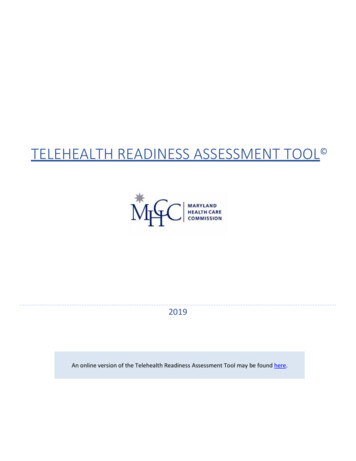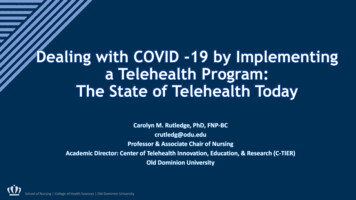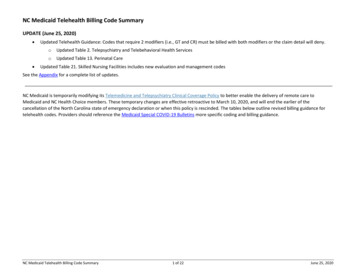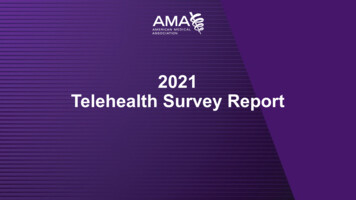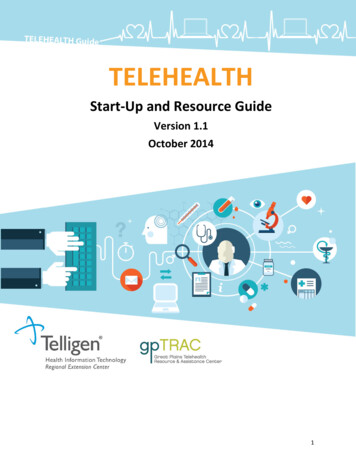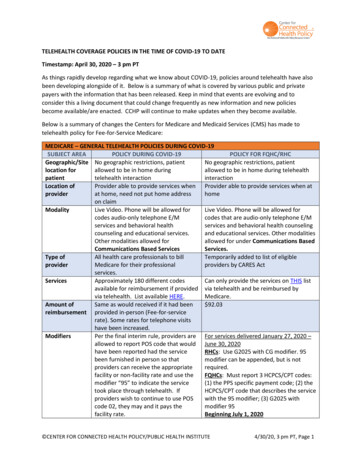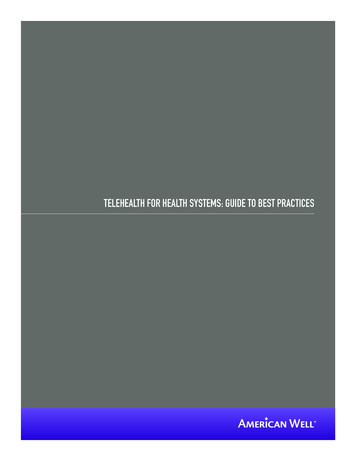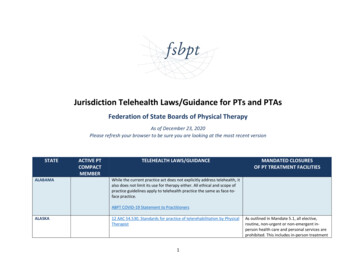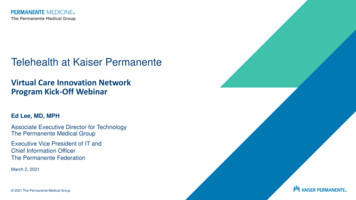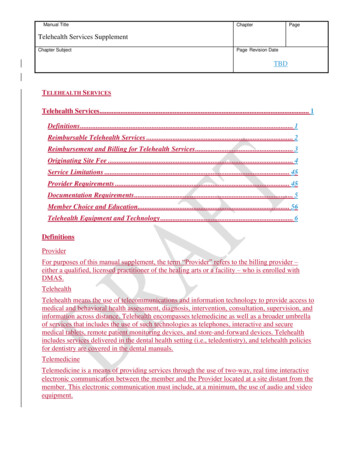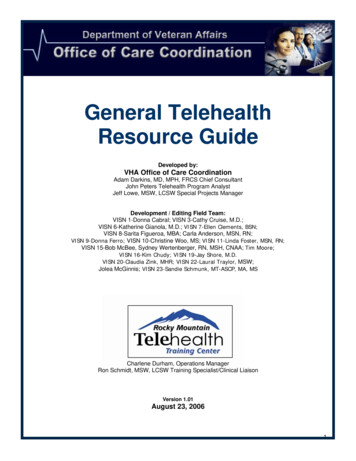
Transcription
General TelehealthResource GuideDeveloped by:VHA Office of Care CoordinationAdam Darkins, MD, MPH, FRCS Chief ConsultantJohn Peters Telehealth Program AnalystJeff Lowe, MSW, LCSW Special Projects ManagerDevelopment / Editing Field Team:VISN 1-Donna Cabral; VISN 3-Cathy Cruise, M.D.;VISN 6-Katherine Gianola, M.D.; VISN 7-Ellen Clements, BSN;VISN 8-Sarita Figueroa, MBA; Carla Anderson, MSN, RN;VISN 9-Donna Ferro; VISN 10-Christine Woo, MS; VISN 11-Linda Foster, MSN, RN;VISN 15-Bob McBee, Sydney Wertenberger, RN, MSH, CNAA; Tim Moore;VISN 16-Kim Chudy; VISN 19-Jay Shore, M.D.VISN 20-Claudia Zink, MHR; VISN 22-Laural Traylor, MSW;Jolea McGinnis; VISN 23-Sandie Schmunk, MT-ASCP, MA, MS .Charlene Durham, Operations ManagerRon Schmidt, MSW, LCSW Training Specialist/Clinical LiaisonVersion 1.01August 23, 20061
Table of ContentsSection 1: Background and Resource Guide Introduction .4Background4Care Coordination General Telehealth (CCGT)4Resource Guide Introduction6Section 2: Start Up Guide.7Introduction7Step 1: Selection of a Development Team8Step 2: Identify the Existing Primary Care, Consultative Services and Inventory Resources that Support theMission and Goals9Step 3: Clinical / Patient Needs Assessment10Step 4: How will you use the telehealth network to address clinical processes identified above?10Step 5: Technical Aspects - Identify Unique Requirements12Step 6: Identify Specific Operating Processes to Integrate Telehealth14Step 7: Identify Methods to Monitor, Evaluate and Sustain the New Program16Section 3: Telehealth Application Planning Essentials .17Clinical Planning Considerations17Data Resources for Needs Assessment17Clinical Services18Technical Planning Considerations Issues20Planning the Telehealth Environment43Administrative / Business Planning Considerations52Feasibility and Sustainability52Challenges53Section 4: Telehealth Clinical Operations .54Clinical Champions54The Needs Assessment54Human Factors54Documentation55Credentialing and Privileging55Clinical Policies & Procedures56Patient Informed Consent56Risk Management57Creating the Clinical Environment57Staff Roles & Responsibilities58Scheduling60Store and Forward Virtual Visit60Section 5: Telehealth Business Operations.62Strategic Plan62Developing a Budget62Elements for Implementation63Staffing63Governance & Support63Technical Support65Marketing65Promotion66Evaluation67Coding and Workload Credit67Billing and Collections70Data Management70Section 6: Telehealth Technical Operations .71Technology Procurement / Purchasing71Scheduling74Information Security74Matching patients and technologies74Informatics Support742
ComplianceThe Telehealth Encounter: Technical aspects7475Section 7: Human Resources .78Sample Position Descriptions78Competencies78Orientation78Section 8: Training and Competency .80Education and Training of Staff80Educational Initiatives80Telehealth Educational Opportunities80Rocky Mountain Telehealth Training Center (RMTTC)81Sunshine Training Center82Teleretinal Training Center82Satellite Broadcasts82Section 9: Continuous Performance Improvement .83Clinical83Business84Technical84Formal Evaluation86Section 10: Research / Resources / Links.87VA Related Publications87VA Web Links88Non-VA Web Links88General Telehealth Groups89Research89Section 11: Glossary and List of Terms .913
Section 1: Background and Resource Guide IntroductionBACKGROUNDVA’s Office of Care Coordination (OCC) was established in July 2003, having evolved from the preexistingTelemedicine Strategic Healthcare Group. In November 2003 a name change was announced that VHATelemedicine is now VHA Telehealth. The new name is a broader umbrella term that covers not only telemedicine(which traditionally is thought of as a licensed independent health care provider directing or providing clinicaltreatment when distance separates the participants), but also covers additional related care and support activitiesfrom various VHA staff, such as a dietician providing diabetes patient education via videoconferencing.OCC supports the development of new models of care in VA that use leading edge health information technologiesto address pressing health needs of veterans. Care coordination in VHA is defined as:"The wider application of care and case management principles to the delivery of health careservices using health informatics, disease management and telehealth technologies to facilitateaccess to care and improve the health of designated individuals and populations with the intent ofproviding the right care in the right place at the right time."This intent is precisely OCC’s mission.The Vision of Office of Care Coordination is:to improve quality, convenience, and access for veteran patients to general and specialty carewithin hospital and clinic settings by the use of health informatics, telehealth and diseasemanagement technologies that enhance and extend care and case management.VA’s Office of Care Coordination outlines three distinct types of telehealth programs:Care Coordination Home Telehealth (CCHT): Patients are assessed and monitored in their home using telehealth technologies for preventive care,intervention and/or treatmentCare Coordination General Telehealth (CCGT): Real-time (synchronous) exchangeTelehealth that involves an interactive exchange between the patient and the provider via telehealth technology(e.g. video teleconferencing)Care Coordination Store and Forward Telehealth (CCSF): Asynchronous exchangeThis type of telehealth involves a form of technology where a single image, series of single images, audiovisualclip, or other form of multi-media clinical data is derived and stored during a clinical encounterThe data is transmitted or forwarded to (or retrieved by) another practitioner at a later time for the purposes ofproviding a consultation or reportSince the patient’s procedure does not coincide with the provider’s interpretation of the data, this is sometimesreferred to as an asynchronous form of telehealthCARE COORDINATION GENERAL TELEHEALTH (CCGT)Definition:Care Coordination General Telehealth (CCGT) involves real-time videoconferencing technologies, with supportiveperipheral devices, to provide care and consultation between clinics and hospitals, or hospitals and otherhospitals (e.g. telemental health, telerehabilitation, etc.).Applications:In developing General Telehealth, VA has focused on the needs of veteran patients as the main driver to prioritizeareas of care. Consequently the first applications of CCGT in VA are:4
Telemental ryOutcomes:Typical CCGT services are designed to achieve: Increased access to specialist consultationsImproved access to primary and ambulatory careReduced waiting timesAlternatives to long-term institutional careImplementation:The strategy for implementing CCGT in VHA is taking place in four stages: Identifying the health needs of veteran patients that telehealth can address appropriately and cost-effectivelyDetermining suitable clinical processes to meet these health needs that can be supported by telehealthtechnologiesDesigning telehealth services that use off-the-shelf telehealth products to support clinical processes to meetidentified health care needsEnsuring the required managerial and business support structures are in place to implement and sustaintelehealth services in VHANetworks:VHA is committed to developing a framework of telehealth technology to enhance the delivery of seamless healthcare services to our patients. To achieve this seamless system, it is imperative that we build programs from asingular base that encourages creativity and flexibility while maintaining quality and efficiency. Due to limitedcapacity of our information infrastructure, program coordination is necessary to maintain dependability and qualityimages for clinical services.To build a Coordinated Telehealth Network we need: VA-wide equipment compatibility, connectivity and interoperabilityStandardized video, audio and data transmissions for optimal qualitySystematized data collection for evaluation of electronic health care initiativesCollaboration among the various levels of care early in the program planning activitiesBenefits of a Coordinated Telehealth Network include: High quality telehealth clinics and applicationsReduction in duplication of services or effortsConsistency and availability of training for practitioners engaged in telehealth care and consultingConsistency and availability of training for support staff engaged in telehealth activitiesDependable telehealth technology and programs5
RESOURCE GUIDE INTRODUCTIONThis Resource Guide has been produced as a collaborative effort between VHA clinicians and administratorsinvolved in delivering telehealth services. The primary focus of this Resource Guide for CCGT is real-timevideoconferencing. However there are references and links to the full spectrum of integrative and hybrid telehealthservices offered in the VA system, including: Real-Time (Videoconferencing) Telehealth Systems between VHA facilitiesStore and Forward Telehealth Systems between VHA facilitiesHome-Based Telehealth Systems with video or imaging capability (e.g., video monitors with peripherals formonitoring vital signs, etc. and video telephones)Other non-video Home-Based Telehealth Systems including in-home messaging devicesThis primary focus of this Resource Guide is telehealth activities between two clinical settings. Specifically, CCGTinvolves a patient site (originating site) and a provider site (distant site): Telehealth activity between two VA Medical Centers (VAMC’s)Telehealth activity between a VAMC and a Community Based Outpatient Clinic (CBOC)Telehealth activity between Centers of Specialized Care (e.g., Spinal Cord Injury (SCI), Traumatic Brain Injury(TBI), and Multiple Sclerosis (MS) and other VAMCsAlthough this Resource Guide will reference the patient’s home and other telehealth settings, specific issuesregarding the home setting are addressed more thoroughly in the Care Coordination Home TelehealthOrientation Packet.The purpose of this Resource Guide is to integrate the practices and procedures used in VHA Telehealth for thebenefit of patients and practitioners. This integration of processes and procedures applies to: Establishing a new telehealth serviceRevising or reviewing an existing telehealth serviceThe Resource Guide has two interdependent parts: The Start Up Guide – This is a straight forward 7-Step process to design and deploy your telehealth program.Resource Support Materials that will assist your start up activities.Website links will be included throughout the text to facilitate direct connection to such items as VHA directives.Additional policies and surveys will be attached and referenced throughout the text.6
Section 2: Start Up GuideINTRODUCTIONThis program planning start-up guide provides a structured 7-Step process that your team can use to design anddeploy a new telehealth program. During this process your team will have the opportunity to consider howtelehealth technology and techniques could be used to enhance the primary patient care and consultative servicesto veterans across the country.The process ensures that necessary components for the development of the program are effectively consideredand communicated through the organization.Planning steps: Each facility in the telehealth network will be creating a new telehealth program and will need toeffectively plan and implement their program to ensure the overall success of this important national initiative. Keyactivities include:1. Select a development team2. Identify the existing primary care, consultative services and inventory resources that support the TelehealthNetwork mission and goals3. Complete a clinical/patient needs assessment4. Identify opportunities to use the Telehealth technologies to support the program mission and goals5. Identify technical aspects of the Telehealth application(s)6. Identify specific operating processes to integrate Telehealth Network activities into current operation (theACTION PLAN)7. Identify methods to monitor, evaluate and sustain the new program7
STEP 1: SELECTION OF A DEVELOPMENT TEAMThe selection and use of the development team is a very important part of the new program development process.New initiatives need passion and energy to succeed. The core team needs enough power to lead the changeefforts and effectively communicate the new vision and strategies. The core team will spearhead the planning andimplementation of local telehealth applications using Steps 2-7 below as guidelines. The total development teamwill provide the detailed operational and technical planning support for the program. Typically, the followingindividuals would be part of the overall team.Team MemberThe Clinical Lead for the proposedtelehealth servicesCORE TEAMThe Implementation Coordinator (oftenselected by Clinical Lead)An enthusiastic support member of theExecutive Leadership TeamThe local telehealth coordinator (if thisexists in your facility, VISN)A representative from IT (InformationTechnology)DEVELOPMENT SPECIALTY AREASThe local facility Local Area Network(LAN) ManagerThe VISN Wide Area Network (WAN)ManagerA VISN videoconferencing specialistThe local credentialing coordinatorA local DSS representative(Decision Support System) for codingworkloadA local representative from HIMS(Health Information ManagementSystems) for coding Clinical Care &ConsultationThe Information Security OfficerOther members of the telehealth teamVeterans and their CaregiversThe local telehealth serviceadministratorOthers at the facility that bring specialrelated skills or influence.FunctionName andContact InfoTeam leaderTelehealth Team Leader schedulesmeetings, ensures that tasks arecompleted etc.Establishes a sense of urgency,promotes the new program vision,facilitates change, removes obstacles,opens doorsEnsure continuity with facility and VISNplan for telehealth; serve as a liaison withOCC as neededProvide technical expertise; insurecontinuity with VISN informatics planProvide technical expertise, insurecompatibility with facility informaticsstructureProvide technical expertise, insurecompatibility with VISN informaticsstructureProvide technical expertise and dailylogistics supportEnsure compliance with VA Directives onCredentialing & PrivilegingEnsure appropriate workload creditcoding structure is set up and utilized tofeed national VA activity databaseEnsure clinical workload is codedappropriately and transmitted to CO andworkload reports are generated andutilizedEnsure compliance with VA DirectivesProvide clinical feedbackProvide feedbackProvide logistic supportProvide feedbackThe Core Team can effectively accomplish the Telehealth Network Mission and lead the development efforts by: Acting as the clinical, technical and organizational champions for this new initiative and ensuring buy-in andadoption within their center/facility.Establishing a sense of urgency for being prepared to provide the best care and continuity along the continuumfor patients.Communicating the Vision and Strategy for the new service throughout the facility and being the role models forthe development efforts.8
Empowering the development team to take the necessary actions that remove obstacles and design creativesolutions for timely implementation.Planning for visible improvements/accomplishments that produce “wins that are recognized” for all participants.Anchoring the new system into the culture of the “service” system of care.Once the team members are identified, it will be important to meet on a regular basis (and on an ad hoc basis asnecessary). Not all members will be required for every meeting and the input or assistance of some members willonly be required for a portion of the development process.Depending on the evolution of telehealth programs within specific VISNs, facilities and service lines, theImplementation/Telehealth Coordinator role may be served by one staff person or multiple staff persons. Also,some programs may have a Clinical Lead Telehealth Coordinator while other programs may have an AdministrativeLead Telehealth Coordinator.STEP 2: IDENTIFY THE EXISTING PRIMARY CARE, CONSULTATIVECONSULTATIVSERVICES AND INVENTORY RESOURCES THAT SUPPORT THEMISSION AND GOALSWith this step your team will examine current program resources and processes. What are your strengths? Howare you currently meeting the needs of patients with “specific service” needs? How might the use of telehealthmodalities improve these processes? The following table contains examples. Please add details that your teamidentifies as relevant for your sultationEmailTelephoneSpecialty TeamPatient/Family/Care-GiverInteraction with care teamsFace-to-FacePrimary and SpecialtyTeamsPatient TransferDoD ConsultationAir/Ground/SeamlessTransition GoalE-mail, phone;videoconference withPolytrauma Rehab CenterLimitationsNo Systematic Approach; noopportunity for visualconsultationNo opportunity for interactionwith distant team other thanby phone; no visual interactionCare TeamsPatients, Social WorkerContinuum UninsuredCare Teams connect toDoDNo ability for teams toconnect with DoDDistant teams not finalized inall sites; communication withLocal teams not establishedNeed equipment; ability forreliable, high speedconnectionPersonnelLocal team in placeDistant Site Care TeamsdevelopingEquipmentSome telehealthcapabilities but nostandardizationLocal and Distant CareTeamsSpaceSome allotted spaceCare Teams need todedicate spaceNeed space to be dedicatedTemplates availableNeed to develop ServiceAgreements between localand distant sites and DoD asneededService AgreementsEmergingOther9
STEP 3: CLINICAL / PATIENT NEEDS ASSESSMENTIn order to implement the Telehealth Network most successfully within a VISN, one needs to have a thoroughunderstanding of the volume, scope and complexity of cases that the Network is expected to serve. The data listedbelow should be reviewed with all members of the telehealth development team to ensure that adequate resourcesare in place to achieve the best results.DATA VARIABLES: Clinical: outpatient encounters, inpatient stays, ICD-9 codes, length of stay, clinic wait times, hospitaladmission rates, annual number of clinic and Emergency Room visitsFiscal data may be utilized to determine high cost patients within a given clinic or VISN.Trends in Patient uniques, utilization, costs, inpatient, outpatient, fee basis, pharmacy costs, lab costs, waitsand/or delays, service area, patient geographic resident locations, no-shows, compliance with medical plans.STEP 4: HOW WILL YOU USE THE TELEHEALTH NETWORK TOADDRESS CLINICAL PROCESSES IDENTIFIED ABOVE?A Telehealth Network is an excellent tool to use to promote seamless care delivery between the originating(patient) and distant (provider) sites. The Network may be used to provide care, consultation, and education.Specific examples include: A veteran is ready for discharge from a Polytrauma Rehabilitation Center (PRC). He will be transferred to aPolytrauma Network site in a distant VISN in one week. Prior to discharge, the interdisciplinary teams at thedifferent sites can hold a videoconference to review the treatment plan including progress to date and goals.The patient may be present; enabling him/her to meet the new team before discharge actually occurs. Thevideo transfer reassuringly underscores for everyone (clinical team, patient and their caregiver) the coordinationand continuity of care for patient.A veteran presented to his local Community Based Outpatient Clinic (CBOC) for a dermatology appointment.The veteran had a lesion that his primary care provider (at the CBOC) wanted advice from a dermatologist onthe proper course of treatment. The dermatologist was located at a VAMC about 120 miles away from thepatient’s home. The primary care provider presented the patient via videoconferencing equipment to a distantsite dermatologist. The dermatologist performed a problem focused history, an examination of the lesion andprovided advice. The primary care physician noted the advice and wrote the appropriate orders for treatment.A veteran is discharged directly to his local VISN and shows up at the new site for care of a complicated upperextremity amputation. The rehabilitation team at the new site requests consultation from the amputee experts atthe referring site through the Polytrauma Telehealth Network. During this consultation, the patient is seen bythe Level I team via video conferencing monitor. A patient presented to his local VAMC to have specialtydiagnostic evaluation performed. Procedure was performed by local staff under the guidance of a specialtyclinician at another VAMC, 500 miles away. The specialist provided guidance throughout the procedure viavideoconferencing, and diagnostic test results were viewed from a computer that was connected to thevideoconferencing system at the patient site. Discussion regarding test results and treatment plan wasdiscussed between the providers at both locations and with the patient.At a tertiary level VAMC, a patient who is recovering from a heart transplant, not seen very frequently withinVA. The treatment team shares its knowledge and experience related to this case with interested clinical staffin the VISN through a ‘Grand Rounds’ video conference using multipoint telehealth resources within the VISN.10
UseNotes1. Care team Consultation2. Seamless Transition3. Ongoing Communication4. Education5.6.7.8.9.11
STEP 5: TECHNICAL ASPECTS - IDENTIFY UNIQUE REQUIREMENTSThis step guides the team through an analysis of the technical aspects of the proposed Telehealth initiative. Fourmajor considerations are analyzed: the types of data (video, audio, static images, text, medical record information,etc.) that will be communicated through the network; sharing considerations for the data being transmitted; specialconsiderations for presentation of the transmitted data; and the type of communication infrastructure needed tomeet the aforementioned data transmission criteria. (Please see Section 3: Telehealth Application PlanningEssentials of this General Telehealth Resource Guide to a detailed discussion of issues and options.)A. TYPES OF TELEHEALTH DATA:Your planning team should take some time to consider how your telehealth program will use data. For thispurpose, data can be considered to be interactive video, static digital images, CPRS data, radiological images, etc.Some programs will have access to more sophisticated resources than others, for example PACS systems forradiology and peripheral medical devices to use concurrently with videoconferencing system. Explore youravailable resources and consider how to exploit them to maximum benefit.Type of telehealth dataExpectations ofthe data(i.e., quality of the image,the data that makes upthe text.)FrequencyHow often will live videoconference encounterstake place? How often will this data produced?(I.e., how many new X-rays are taken annually?)(daily, monthly, annually) How often is the datarecalled for later use? (daily, monthly, annually)Static images, dynamic images ortextual dataReal-time interactive videoCPRS data (text, images, x-ray, CT,MRI, labs, graphs)CPRS video? (prosthetics, gaitanalysis)CPRS – Electronic Health RecordAre radiology images needed?(Quality – Vista Imaging or Diagnostic)Are medical/ social/ psychologicalinformation trend sequences used tomonitor and manage patient care?OtherB. DATA SHARING: ENSURE COMPLIANCE WITH HIPPA REGULATIONSWill the data be communicated to more than one location (other facilities, other services in the hospital, VISN,DOD, etc)? If yes, with whom?Specify locations:How often will the data be shared or communicated to another location? (daily, monthly, annually)12
C. SPECIAL CONSIDERATIONS Are there any special considerations on how the data is to be presented? (e.g. color, printed, viewed, other)Are there any special considerations on how the data is to be collected? (scanned, video, other)D. TECHNOLOGY ASSESSMENT OF ASSETS AND NEEDSDetailed discussion of technology issues and assessment strategies can be found in Section 3 TelehealthApplication Planning Essentials. Below are examples of items of importance for consideration.Providerlocation:Connectivity: POTS ISDN IPMax Bandwidth: 100KB 384 768 1MegNarrative Description:(N)ew or(E)xisting(R)ent or(P)urchaseInstalled bySupport byV/C niturePatientlocation(s):Connectivity: POTS ISDN IPMax Bandwidth: 100KB 384 768 1MegNarrative Description:(N)ew or(E)xisting(R)ent or(P)urchaseInstalled bySupport byV/C nitureThe quality of service (QoS) on the network is an issue. Unlike other videoconferencing applications, clinicalvideoconferencing is not tolerant of interrupted or dropped video or audio signals, also known as IP packet loss.VHA Office of Care Coordination (OCC) is working with VA Telecommunications and VISN wide area network(WAN) managers to develop QoS standards to eliminate packet loss.13
STEP 6: IDENTIFY SPECIFIC OPERATING PROCESSES TO INTEGRATETELEHEALTHThis step outlines the general operations planning and management activities to ensure that the TelehealthNetwork meets its development objectives and builds a program that is sustainable, effective, and meets the needsof the patients we serve. Following the initial program set up these activities provide the program an operationalbase to apply the continuous quality improvement systems of “Plan, Do, Study, Act” and encourage ongoingprogram improvements aimed at maintaining a best practice. By assigning responsible parties and target dates foraccomplishments, your opportunity for success will be significantly enhanced.Task / IssueResponsibilityTarget DateCommentsPlanningTeam Identify the Project Coordinator Identify the Clinical Lead Select development team membersNeeds Assessment Identify and inventory any existing GTprograms or resources Collect and review pertinent data such asconsult volumes, waiting times Identify gaps/needs for GT services Complete a SWOT Analysis for GTBusiness Plan Identify the specific service(s) to be providedby GT Identify the specific goals of the GT service Develop a performance improvement plan Project the potential volume/workload permonths for this GT service Identify needs fortechnology/equipment/bandwidth Project estimated costs fortechnology/equipment/bandwidth Project any directly related staffing andtraining needs and related costs Identify or develop Service Agreement for theGT service Implementation / OperationBusiness / Admin Negotiate with sister facility or communitysite for GT services14
Develop a Memorandum of Understanding Develop a marketing plan Establish process for scheduling across sites Develop policies and procedures Establish coding structure and process forworkload capture Set-up clinics Create consult templates Establish standard note titles anddocumentation templates Establish process for storing and uploadingany images into VISTA Imaging Develop back up plan for droppedsessions/technical difficulties Collect and analyze performance dataTechnology and Environment Complete a Network telecommunicationsreadiness assessment Identify any location, space, furniture needs Develop trouble-shooting guides for staff Order equipmentStaffing / Training Identify Site Coordinators Develop position descriptions/functionalstatements Develop a plan for ongoing education andtraining of staff Complete orientation and training of allaffected staff Establish and document core competenciesof all involved staffClinical Determine how new telehealth protocols willintegrate with normal clinical practice(Consider ACA principals) Complete required Credentialing andPrivileging Establish process for informed consentwhere applicable Develop patient preparation/orientationprocess15
STEP 7: IDENTIFY METHODS TO MONITOR, EVALUATE AND SUSTAINTHE NEW PROGRAMAdditional detailed material in the Resource Guide provides more in-depth guidance in this area. Following areexamples for thought. Outcomes should be related to the needs identified in earlier sections.Potential Measure Consults CommentsNumber of ConsultsClinical Outcomes DataObtainedWhereClinical Activity / workload Measured How Results / Miles/costs/time/lives/limbssaved Care Results / Miles/costs/time/lives/limbssaved Network Activity and quality Interrupted Consults Dropped Video / Dropped Audio /JitterSatisfaction Surveys: Patient / Caregiver / Provider16
Section 3: Telehealth Application Planning EssentialsThere are three major categori
This program planning start-up guide provides a structured 7-Step process that your team can use to design and deploy a new telehealth program. During this process your team will have the opportunity to consider how telehealth technology and techniques could be used to enhance the primary patient care and consultative services
